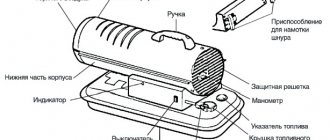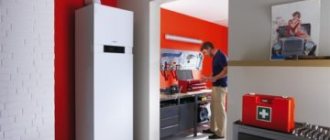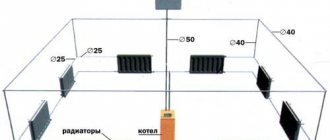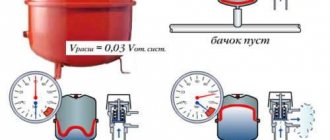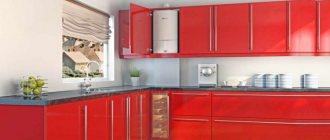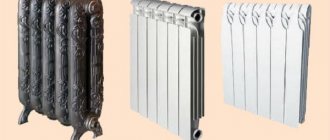How much heat is needed for heating?
To accurately calculate the required amount of heat for a room, many factors should be taken into account : the climatic features of the area, the cubic capacity of the building, possible heat loss from the housing (the number of windows and doors, building material, the presence of insulation, etc.). This calculation system is quite labor-intensive and is used in rare cases .
Basically, the calculation of heat is determined on the basis of established indicative coefficients: for a room with ceilings no higher than 3 meters, 1 kW of thermal energy is required per 10 m2 . For the northern regions, the figure increases to 1.3 kW.
For example, a room with an area of 80 m2 requires 8 kW of power for optimal heating. For the northern regions, the amount of thermal energy will increase to 10.4 kW
Heat load calculation
To determine the thermal load there are several calculation methods. Each of them has its own difficulties and nuances, so it is better to use the methods listed below for a more accurate result. Let's look at three simple ways to calculate the heat load:
- Method 1. There is a simple calculation method that is based on SNiP. 1 kW of thermal power is required to heat 10 sq.m. premises. The result obtained must be multiplied by the regional coefficient. Let's consider some coefficients depending on the region: for a temperate climate the coefficient is from 1.2 to 1.3; for the southern region the coefficient is 0.7-0.9; for the extreme northern region it takes a coefficient from 1.5 to 2;
- Method 2. Although the first method is quite simple, it has many errors, so you should not rely only on its results. First of all, you need to pay attention to the height of the ceilings, which is different in each room. The number of doors and windows in a building also plays an important role. In an apartment there will be much less heat loss than in a private house. All these factors influence the thermal load.
- Let us highlight some adjustments to the method: a heat load of 40 watts is applied per 1 cubic meter of room volume; a window in the room adds 100 watts to the indicator, and a door 200 watts; if the apartment is located in the corner or end of the house, then it has a coefficient from 1.2 to 1.3, and in a private house the coefficient is 1.5;
- Method 3. But the second method, like the first, is not accurate. That is why it is worth using the third calculation method. This method takes into account the resistance of walls and ceilings, as well as the temperature difference between indoor and outdoor air. In order for the room to have a constant temperature regime, an amount of thermal energy is required that will coincide with losses through the building envelope and ventilation system. But in this method all calculations are simplified. Approximately 30 to 40% of the heat is lost through the ventilation system, 10 to 25% is lost through the roof, 20 to 30% of the heat is lost through the walls, and 3 to 6% is lost through the floor, which is located on the ground.
Let's look at some thermal resistance values:
- Brick walls that are laid with 3 bricks have a resistance of 0.592 m2*s/W, with 2.5 bricks - 0.502, with 2 bricks - 0.405, with 1 brick - 0.187.
- Walls made of gas silicate blocks have a resistance of 0.476 for a 20 cm wall, and 0.709 for a 30 cm wall.
- For a log wall, the thermal resistance is 0.550 for a diameter of 25 cm, for 20 cm - 0.440.
- If the thickness of the log frame is 20 cm, then the resistance will be 0.440, and if it is 10 cm - 0.353.
- For a wooden floor the resistance is 1.85, for a double wooden door it is 0.21.
- For plaster 3 cm thick, the resistance is 0.035.
- For the ceiling, the thermal resistance is 1.43.
- For a frame wall 20 cm thick with insulation in the form of mineral wool, the thermal resistance is 0.703.
It is worth paying attention to the following factors: solid fuel boilers should not operate at a power that is less than the rated one. It is necessary to calculate the heat load for heating.
If you comply with all the requirements and rules before installing the heating system, it will work without interruptions, and you can also save on unnecessary costs.
Heat dissipation is a key performance indicator
The heat transfer coefficient of radiators is an indicator of its power. It determines the amount of heat generated over a certain period of time. The power of the convector is influenced by: the physical properties of the device, its type of connection, temperature and speed of the coolant .
The power of the convector, indicated in its data sheet, is determined by the physical properties of the material from which the device is made, and depends on its center distance. To calculate the required number of radiator sections for a room, you will need the area of the home and the heat flow coefficient of the device.
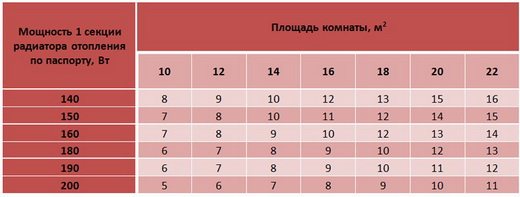
Calculations are made using the formula:
Number of sections = S/ 10 * energy coefficient (K) / heat flow value (Q)
Example : It is necessary to calculate the number of sections of an aluminum battery (Q = 0.18) for a room with an area of 50 m2.
Calculation: 50 / 10 * 1 / 0.18 = 27.7. That is, to heat the room you will need 28 sections. For monolithic devices, instead of Q, we set the heat transfer coefficient of the radiator and as a result we obtain the required number of batteries.
If convectors are installed next to sources that affect heat loss (windows, doors), then the energy coefficient is taken from the calculation - 1.3.
Radiators are used for heating: steel, aluminum, copper, cast iron, bimetallic (steel + aluminum) , and they all have different heat flow values due to the properties of the metal.

Find out how to calculate the number of sections in bimetallic radiators?
Read here for radiator connection diagrams for a private home, how to choose the best option.
How to choose a good oil radiator for your home: tips, recommendations, benefits and harms.
Which heating radiators have the highest heat output?
As for the characteristics of metals, steel has the lowest heat transfer, and bimetal (a combination of aluminum and steel) has the highest.
| Material | Heat dissipation (W/m*K) |
| Steel | 47 |
| Cast iron | 52 |
| Aluminum | 202-236 |
| Bimetal | 380 |
However, these are only the properties of metals that represent the overall picture. Heat transfer, to a lesser extent, also depends on the center distance, section area, and manufacturing technology. Therefore, we recommend considering the effectiveness of each type of radiator as a whole, and then comparing the specific most successful models, choosing the most effective of them.
Bimetallic
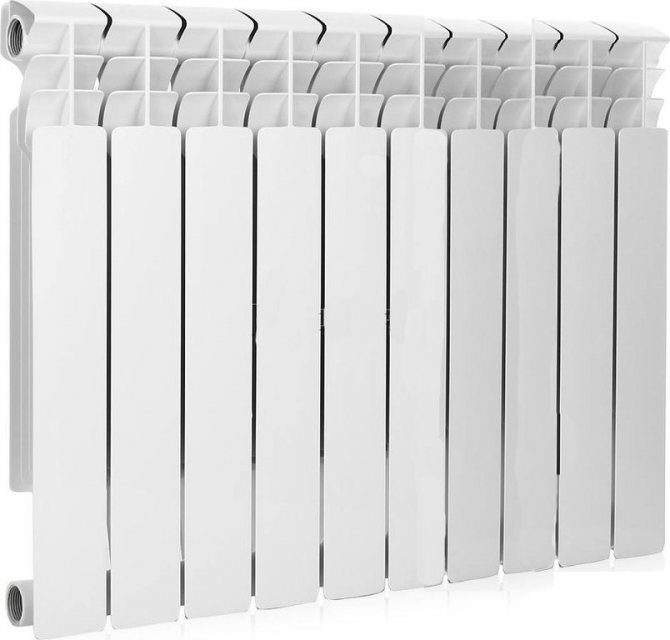
On average, the heat transfer rate of bimetallic radiators is the highest. Depending on the model - from 140 W to the maximum power on the market of 280 W per 1 section (model Sira RS 800). They are a combination of steel conductive channels and aluminum fins, heat up quickly and immediately release heat.
The devices are designed for system operating pressures up to 35 atm. Even the simplest models have a service life of at least 20 years. Cost per section is 395-2190 rubles.
Aluminum
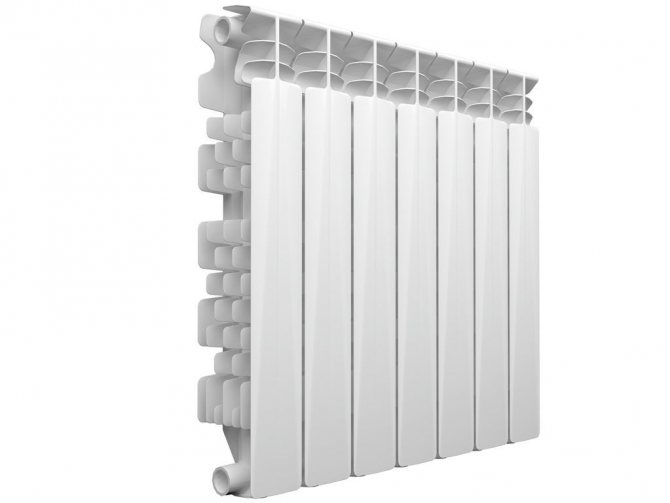
The heat transfer rates of aluminum heating radiators are close to bimetallic; some expensive models may have higher power and efficiency than simple bimetallic devices.
Depending on the model, the thermal power can range from 130 W to 220.9 W per 1 section (model Roca Dubal-80). With high efficiency, they, in comparison with bimetallic ones, have many operational nuances. When choosing, you need to pay attention to the operating pressure, sometimes it does not even exceed 10 atm.
The main disadvantage is the need to maintain a certain acidity of the coolant (water), which is difficult even in a private house, not to mention an apartment with central heating. Otherwise, pH levels above 7.5 will quickly destroy the devices. The cost of 1 element is from 350 to 1200 rubles.
Steel
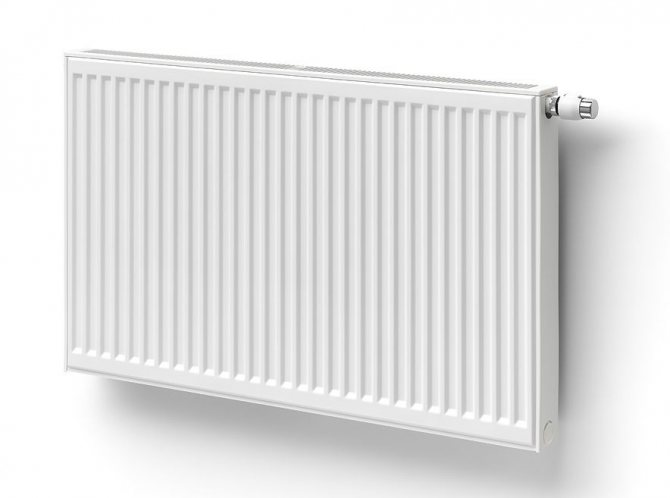
The thermal power of steel panel batteries is relatively small, but optimal, especially in terms of price-result ratio. They heat up quickly, have better convection characteristics (the air warms up noticeably faster), but also cool down quickly. Depending on the model, the heat output is 179-13,173 W (model Kermi FTV 330930).
Specific thermal power of current formula
| Work and current power. Joule–Lenz law |
| Let us consider an arbitrary section of the circuit, to the ends of which a voltage is applied U . During time d t charge passes through each section of the conductor In this case, the forces of the electric field acting in this area do work: Dividing work by time, we obtain an expression for power: |
| (7.7.1) |
It is useful to remember other formulas for power and work:
| (7.7.2) |
| (7.7.3) |
In 1841, Manchester brewer James Joule and in 1843, St. Petersburg academician Emilius Lenz established the law of the thermal effect of electric current.
| Joule James Presscott (1818 - 1889) - English physicist, one of the discoverers of the law of conservation of energy. His first lessons in physics were given to him by J. Dalton, under whose influence Joule began his experiments. The works are devoted to electromagnetism and the kinetic theory of gases. |
| Lenz Emilius Christianovich (1804 – 1865) – Russian physicist. Main works in the field of electromagnetism. In 1833 he established the rule for determining the electromotive force of induction (Lenz's law), and in 1842 (independently of J. Joule) - the law of the thermal action of electric current (Joule-Lenz law). Discovered the reversibility of electric machines. Studied the dependence of the resistance of metals on temperature. The works also relate to geophysics. |
Independently of each other, Joule and Lenz showed that when current flows, an amount of heat is released in the conductor
:
| (7.7.4) |
If the current changes with time, then
.
This is the Joule–Lenz law in integral form
.
This shows that heating occurs due to the work done by field forces on the charge.
Relationship (7.7.4) is integral and applies to the entire conductor with resistance R
, through which current
I
. Let us obtain the Joule-Lenz law in local differential form, characterizing the heat release at an arbitrary point.
Thermal current power
in a conductor element Δ
l
, cross-section Δ
S
, volume is equal to:
Procedure for calculating heat transfer
So, the actual power of the heating battery is much less than declared, but to select it you need to understand how much. There is a simple way to do this: applying a reduction factor to the nameplate value of the heater’s thermal power. Below is a table of coefficients by which the declared heat transfer of the radiator is multiplied depending on the actual DT value:
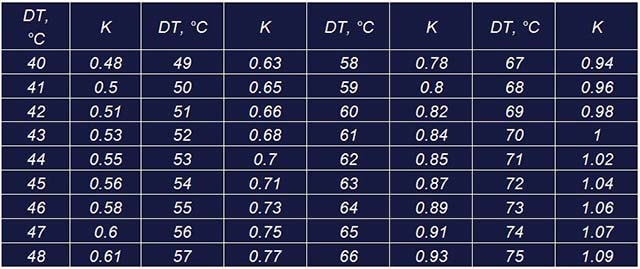
The algorithm for calculating the real heat transfer of heating devices for your individual conditions is as follows:
- Determine what the temperature in the house and water in the system should be.
- Substitute these values into the formula and calculate your temperature difference Δt.
- Find in the table the coefficient corresponding to the found DT.
- Multiply the rated heat transfer value of the battery by it.
- Calculate the number of sections or entire heating devices to heat the room.
In the example given, the thermal power of 1 section of a bimetallic radiator will be 200 W x 0.48 = 96 W. To heat a room of 10 m² it will take approximately 1000 W of heat or 1000/96 = 10.4 ≈ 11 sections (we round up).
The presented table and calculation of the heat transfer of batteries should be used when the documentation indicates Δt equal to 70 °C. But it happens that manufacturers provide radiator power for other conditions, for example, at Δt = 50 °C. Then you can’t use coefficients; it’s easier to dial the required number of sections according to the passport characteristics, just take their number with a margin of one and a half.
Reference. Many manufacturers indicate heat transfer values under the following operating conditions: t = 90 °C, t = 70 °C, t = 20 °C, which exactly corresponds to Δt = 50 °C.
How to independently calculate the required power of heating devices
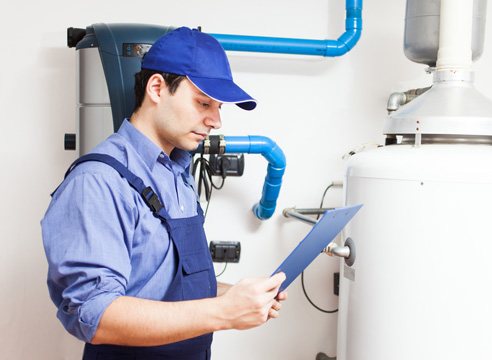
Professional calculation
To determine this value, there are thermal engineering calculations. Professional thermotechnical calculation of heating systems is a very complex task that can only be performed by trained specialists.
However, there are also simplified calculation methods that can be used to approximately determine the power of heating units required for a particular room. They are based on the average thermal characteristics of residential buildings, obtained through many years of monitoring the use of heating systems (also find out at what temperature the authorities turn off the heating).
Formulas and values
So, here are instructions on how to determine the required power of the heating device with your own hands:
- For the middle zone with a minimum temperature in the winter season of -30°C, this value is determined by the following formula:
Q = qv × V , where
Q (kW) – required thermal power; qv – average heating power 1m³; V (m³) – volume of the room.
In this case, it is recommended to use the following qv values: for an ordinary apartment in a panel house qv = 0.04 kW/m³; for a cold apartment (poorly insulated, corner) qv = 0.05 kW/m³; for a well-insulated apartment (insulated walls, plastic windows) qv = 0.03 kW/m³.
Note! Using the above formula, it is impossible to calculate thermal power for other climatic zones.
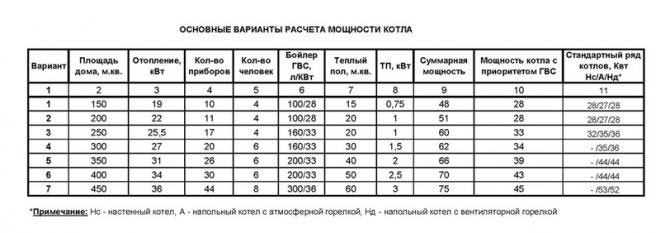
Useful table for choosing boiler power
- And here is the formula for finding the required heating intensity for any other climatic zone: Q = 0.001 × (qvt × V × (tп – toc)) , where
Q (kW) – required thermal power; qvt (W/m³ × °С) – average specific heat. power; tп – room temperature; toc – outside temperature; V (m³) – volume of the room.
In this case, it is recommended to use the following qvt values: for an ordinary apartment in a panel house qvt = 0.8 W/m³ × °C; for a cold apartment qvt = 1W/m³ × °C; for a well-insulated apartment qvt = 0.6 W/m3 ×˚С.
When calculating, as a rule, they take toc = the minimum temperature of the region in the winter season, and tп = the desired temperature in the apartment.
Advice! Were you completely satisfied with the temperature that was in the apartment with centralized heating? Then you can find out this thermal value by counting the number of sections of all batteries installed in the room and multiplying them by the power of one section. For example, the power of one battery section made of cast iron and 60 cm high = 150 W.
But using this formula you can calculate how many radiator sections will be needed to create a comfortable temperature in each room of the house
Do not forget that after determining the required thermal power for the apartment as a whole, you need to distribute it between all rooms in proportion to their area.
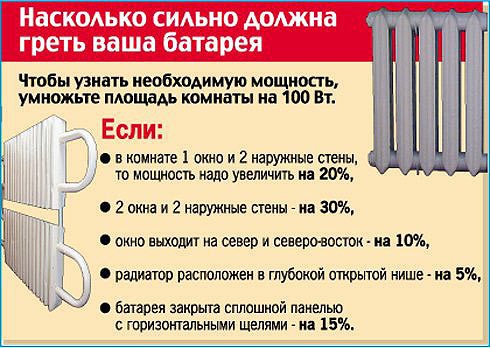
Calculation for batteries
Comparison by thermal power
If you carefully studied the previous section, you should understand that heat transfer is greatly influenced by air and coolant temperatures, and these parameters depend little on the radiator itself. But there is a third factor - the heat transfer surface area, here the design and shape of the product plays a big role. It is impossible to clearly compare a steel panel heater with a cast iron radiator; their surfaces are too different.

It is difficult to compare the heat output of flat panels and ribbed surfaces of complex configurations
The fourth factor influencing heat transfer is the material from which the heating device is made. Compare for yourself: 5 sections of the GLOBAL VOX aluminum radiator with a height of 600 mm will deliver 635 W at DT = 50 °C. A cast iron retro battery DIANA (GURATEC) for 5 sections of the same height will transmit only 530 W to the room under similar conditions (Δt = 50 °C). These data are published on the manufacturers' official websites.
Note. The power characteristics of aluminum and bimetallic heaters differ little; there is no point in comparing them.
You can try to compare aluminum with a steel panel radiator by taking the closest standard size that fits the dimensions. The length of a battery of 5 GLOBAL aluminum sections with a height of 600 mm will be approximately 400 mm, which corresponds to a KERMI 600 x 400 steel panel.
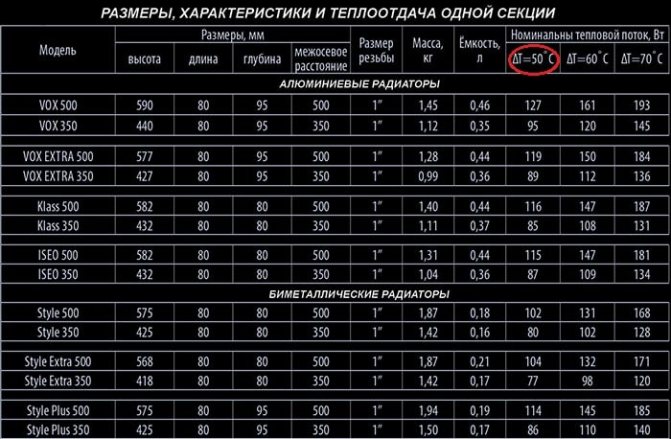
The table shows the thermal performance of 1 section made of aluminum and bimetal depending on the size and temperature difference Δt
Even if we take a three-row steel panel (type 30), we get 572 W at Δt = 50 °C versus 635 W for 5-section aluminum. Also keep in mind that the GLOBAL VOX radiator is much thinner, the depth of the device is 95 mm, and the KERMI panels are almost 160 mm. That is, the high heat transfer of aluminum sections makes it possible to reduce the dimensions of the heater.
In an individual heating system for a private home, batteries of the same power, made of different metals, will work differently. Therefore, the comparison is quite predictable:
- Bimetallic and aluminum products quickly heat up and cool down. By giving off more heat over a period of time, they cool the water returned to the system more.
- Steel panel radiators occupy a middle position, as they transfer heat less intensely. But they are cheaper and easier to install.
- The most inert and expensive are heaters made of cast iron; they are characterized by long heating and cooling, which causes a slight delay in the automatic regulation of coolant flow by thermostatic heads.
Types and thermal efficiency of heating sources in the welding process.
Based on the operating time, a distinction is made between instantaneous sources, which release heat in a very short period of time, and continuously operating ones. The latter, according to the design scheme, can be stationary, mobile and fast moving. As a rule, in the case of manual welding and surfacing, it is advisable to use a moving source circuit, and in the case of automatic welding, it is advisable to use a fast-moving source.
Depending on the size of the zone in which heat is released, concentrated and distributed sources are distinguished. Concentrated sources can be point (heat is released in a very small volume), linear (heat is released along a line) and flat (heat is released in a plane).
In the case of fillet welding on a massive part or surfacing on it, a point source scheme is used for thermal calculations on the surface of a semi-infinite body or flat layer. If the plate is welded with a butt or fillet weld with complete or almost complete penetration, a linear source circuit is used in the plate (heat is introduced evenly throughout the entire thickness along a conventional line). For butt welding of rods, a flat source scheme is used (heat is released in the plane of the joint).
Distributed sources release heat over some surface (in a heating spot). or in a certain volume of the part, and the intensity of heat input (specific heat flux) at different points of the heating spot is not the same. Depending on the distribution law of the specific heat flux over the heating spot, the distributed sources may be different. For laser, arc, plasma or gas welding, this law is close to the law of normal distribution, and the heat sources are called normal. If the heating spot has the shape of a circle, then the source will be normally circular (laser, arc, plasma and gas welding); if the heating spot has the shape of a strip, the source is normally strip (heating the sheet with gas combs).
The effective thermal power of the welding heat source, i.e. the amount of heat introduced during welding by the source into the part per unit time, if the parameters of the welding mode are known, is determined by the formula
where I is the welding current;
U—arc voltage; η is the effective efficiency of the heating process. Table 1. Effective efficiency values of the heating process for different welding methods.
| Welding method | η |
| Manual, electrodes: | |
| melting | 0,7-0,85 |
| coal | 0,5-0,7 |
| Submerged | 0,8-0,95 |
| In shielding gas: | |
| Carbon dioxide | 0,7-0,8 |
| Argon, electrode: | |
| tungsten | 0,65-0,75 |
| melting | 0,7—0,8 |
| Cored wire | 0,8-0,9 |
| Gas flame | 0,3-0,8 |
| Electroslag: | |
| usual with sheet thickness, mm: | |
| 50 | 0,55 |
| 100 | 0,8 |
| 200 | 0,9 |
| With powdered filler metal and sheet thickness, mm: | |
| 50 | 0,75-0,8 |
| 100 | 0,9 |
The heat input of welding, i.e. the amount of heat introduced per unit length of the weld, in this case is found from the expression
where v is the welding speed.
If the welding mode is not known, but the cross-section of the weld metal deposited per pass (butt or fillet) is specified, the heat input can be obtained from the equation
where Fsh is the cross-sectional area of the deposited weld metal, mm2; Qv is the coefficient determined by (Table 2).
When welding corner joints (T-joints, lap joints), part of the heat input introduced into the element being welded is determined depending on the thickness ratio. Thus, in the case of fillet welding to a plate of thickness δ of a structural element of thickness δk, the heat input introduced into the plate qp.p and into the structural element (rib, wall, cover) qp.k can be calculated using the formulas:
The effective thermal power in these cases is determined using similar formulas:
Table 2. Qv values for various welding methods
| Welding method | Welding materials | Qv, J/mm3 |
| Manual electric arc | Electrodes: | |
| SSSI - 13/45 | 65 | |
| EA 395/9, EA 606/10, EA 400/10 | 42 | |
| EA 606/11, 48N-1 | 46 | |
| EA 981/15 | 48 | |
| Semi-automatic in CO2 | Wire Sv-08GS | 38 |
| Automatic and semi-automatic submerged arc | Wire Sv-08A, flux OSTS-45 | 65 |
| Wire Sv-10GSMT, flux AN-42 | 71 |
Formulas (4-7) give the most accurate results for δ/δк≤1.7. They are valid for low-carbon, low-alloy and austenitic steels, as well as titanium and aluminum alloys up to approximately 16 mm thick.
Comparison by other characteristics
One feature of battery operation – inertia – has already been mentioned above. But in order for the comparison of heating radiators to look objective, in addition to heat transfer, other important parameters should be taken into account:
- working and maximum coolant pressure;
- amount of water held;
- weight.
The operating pressure limitation determines whether the heating device can be installed in multi-storey buildings, where the height of water lifting by network pumps can reach hundreds of meters. The parameter does not matter for private houses, where the pressure in the system is low, maximum 3 Bar.
Comparing the capacity of radiators can give an idea of the total amount of water in the network that will have to be heated. Well, the weight of the product is important when choosing the installation location and method of attaching the battery.
As an example, below is a comparison table of the characteristics of various heating radiators of the same size:
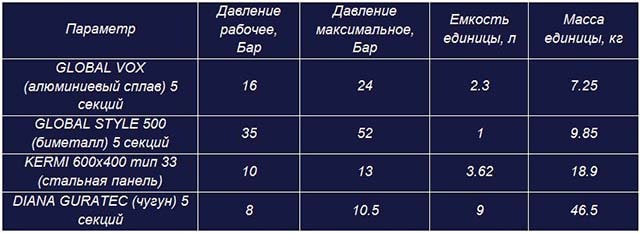
Note. In the table, a heating device consisting of 5 sections is taken as 1 unit, except for the steel one, which is a single panel.
Features of connecting radiators
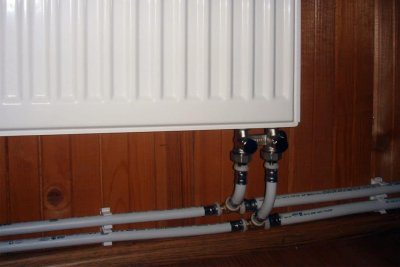
Connecting batteries to the heating system is of great importance only with natural circulation .
In this case, the principle is that all radiators are completely filled with coolant and do not form counter currents. But when using forced circulation, this factor does not matter.
How to calculate how many sections are needed?
To heat all the rooms, you will need to know the power that will be required for each room, only after this will you calculate the heat transfer of the battery. Calculating the heat that will be required to heat the room is necessary in order to find out how many sections the radiator should consist of.
To determine how much heat is required to heat a room, a fairly simple formula is used. Based on the location, the amount taken is the amount of heat that is required per 1m3 of the room; for the south side this value will be 35 W/m3 and 35 W/m3 for the north. Thus, the volume of the required room is reduced by one of the values and as a result we find out the required power.
To calculate the power of bimetallic or aluminum batteries, you need to take into account the parameters specified by the manufacturer in the passport. Based on these data, for one section of the battery at DT = 70. This indicates what the heat flow is equal to at a supply temperature of 105 ºС, and at a return temperature of 70 ºС. This is taking into account that the temperature inside the room will be about 18ºС.
Based on the data in our table, for a bimetallic radiator, one section with an interaxial size of 500 mm is 204 W, but taking into account the fact that the coolant temperature in the supply will be 105ºC.
Power calculation. Current systems, especially individual ones, do not heat the coolant that much, which means that the heat flow will be less. To obtain real values, it is necessary to calculate the DT characteristic for specific conditions using the formula:
DT = (tflow + trev) / 2 – troom,
where: tpod – water temperature in the supply pipeline; tobr - the same, in the return; troom – temperature inside the room.
After this, the heat transfer indicated in the product passport must be multiplied by a correction factor, which is taken in accordance with the DT values according to the table:
For example, the coolant temperature is 80/60°C, the temperature in the room will be 21°C, the DT characteristic will be equal to (80 + 60) / 2 – 21 = 49, the correction factor will be 0.63. In this case, the heat flux from one section of the same bimetallic radiator will be equal to 204 * 0.63 = 128.5 W. Based on these data, the required number of sections is selected that will warm the room well.
Easy to calculate
Now that we have figured out what indicators should be taken into account in the formula, it no longer seems so complicated. It is enough to do the calculations once to understand how convenient it is.
Indeed, during the construction of a house and even after that, the owner remains with a detailed graphic plan of each room with dimensions, taking into account the cardinal directions. It is also not difficult to foresee the influence of the climatic features of the region. The only thing you need to do is clarify some of the nuances by walking around the site with a tape measure.
Analyze which rooms are located above and below, where the windows are and what radiator installation scheme is used. Then you can easily calculate the thermal power that will be required to maintain a comfortable indoor temperature.
It will be easier for you to work with indicators if you immediately enter them into a notebook by drawing a special table. You can subsequently enter the calculation results into it. The built-in calculator, with the above mentioned coefficients, will help you make the final calculations.
If there are difficulties in obtaining any of the indicators listed above, you can not take them into account. The result will still take into account the most favorable conditions.
Which radiators have the best heat transfer?
As can be seen from the table below, which compares the heat transfer of heating batteries, bimetallic heating radiators have the highest power. They are a ribbed aluminum body, inside of which there is a durable welded frame made of metal tubes designed for the flow of coolant.
This type of heating equipment is perfect for installation in a private house with an individual system, as well as for a centralized heating system. The main disadvantage of such products is their high cost. However, the best heat transfer of bimetallic heating radiators often allows you to make a choice in their direction.
Additional factors affecting heat transfer
This indicator is also affected by:
- Connection type.
- Features of accommodation.
The radiator can be connected in the following ways:
Most manufacturers believe that the owner will make
a diagonal connection, because it is the most effective. It consists of connecting the inlet pipe to the pipe located at the top of the heating device, and connecting the outlet pipe to the pipe located at the bottom of the opposite end. Thanks to this, the coolant can easily fill all sections and transfer heat to every particle of the heating radiator. In this case, it is not necessary to create very high pressure to move water or other heated liquid.
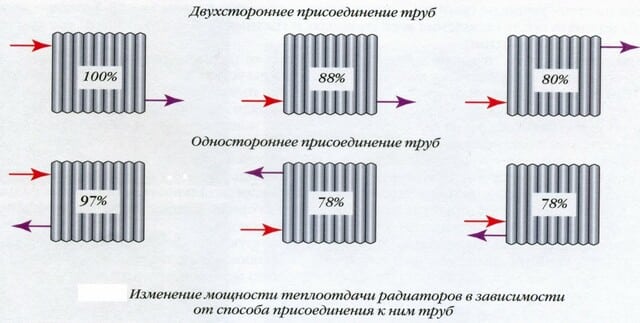
This leads to poor heating of the last ribs. According to statistics, heat loss is 7%. The lower connection diagram results in 20% losses. Heat transfer losses in the last two connection schemes to a heating device can be minimized by using forced circulation of heated liquid. Even a small pressure is enough to completely warm up all sections.
Battery placement is very important. If it is installed crookedly, air pockets will form in some sections. Heat transfer will be less.
The loss of heat transfer can be like this:
- 7-10% - if the permissible distance between the device and the window sill is exceeded. It should be 10-15 cm;
- 5% - if the distance between the wall and the battery is reduced. The optimal size is 3-5 cm;
- 7% - in a situation where the distance between the floor and the radiator is not maintained. It should be 10-15 cm.


